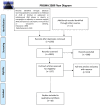Sarcopenic Obesity in Children and Adolescents: A Systematic Review
- PMID: 35721709
- PMCID: PMC9198401
- DOI: 10.3389/fendo.2022.914740
Sarcopenic Obesity in Children and Adolescents: A Systematic Review
Erratum in
-
Corrigendum: Sarcopenic obesity in children and adolescents: a systematic review.Front Endocrinol (Lausanne). 2023 Aug 15;14:1269546. doi: 10.3389/fendo.2023.1269546. eCollection 2023. Front Endocrinol (Lausanne). 2023. PMID: 37654559 Free PMC article.
Abstract
Sarcopenic obesity (SO) is defined as co-occurrence of increased fat mass and sarcopenia and may predict adverse health outcomes in the pediatric population. However, the prevalence of SO and its association with adverse health outcomes have not been well defined in children and adolescents. We systematically reviewed data on the SO definition, prevalence, and adverse outcomes in the pediatric population. A total of 18 articles retrieved from PubMed or Web of Science databases were included. Overall, there was a wide heterogeneity in the methods and thresholds used to define SO. The prevalence of SO ranged from 5.66% to 69.7% in girls, with a range between 7.2% and 81.3% in boys. Of the 8 studies that evaluated outcomes related to SO, all showed a significant association of SO with cardiometabolic outcomes, non-alcoholic fatty liver disease (NAFLD) severity, inflammation, and mental health. In conclusion, this review found that SO is highly prevalent in children and adolescents and is associated with various adverse health outcomes. Findings of this review highlight the need for the development of a consensus regarding definition, standardized evaluation methods, and age and gender thresholds for SO for different ethnicities in the pediatric population. Further studies are needed to understand the relationship between obesity and sarcopenia and SO impact on adverse health outcomes in children and adolescents.
Keywords: adolescents; children; muscle mass; muscle strength; obesity; sarcopenia.
Copyright © 2022 Zembura and Matusik.
Conflict of interest statement
The authors declare that the research was conducted in the absence of any commercial or financial relationships that could be construed as a potential conflict of interest.
Figures
References
-
- WHO . Overweight and Obesity. Available at: https://www.who.int/news-room/fact-sheets/detail/obesity-and-overweight (Accessed 1.12.2021).
Publication types
MeSH terms
LinkOut - more resources
Full Text Sources
Medical


